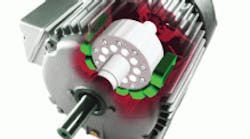Efficiency lets smaller motors handle bigger jobs
Platinum e Motors from Leeson Electric Corp., Grafton, Wis., use a range of advanced features that increase their efficiency and power density, letting customers get more power out of smaller motors. The permanent-magnet ac motors are also built to CI Severe Duty standards, making them suitable for use in harsh environments.
Platinum e motors use a different type of rotor than most other induction motors. In squirrel-cage motors, current is induced into the rotor from the field (stator) through an air gap, and conducted through a bar of aluminum or other conductive material. These bars are most often die cast and mounted in the rotor laminations’ slots. In Platinum e motors, the rotor itself contains permanent-magnet material, which is surface mounted to the rotor lamination stack or embedded within the laminations. In both cases, electrical power is supplied through the stator windings.
The motors use concentrated windings, essentially a bobbin winding. Therefore, unlike distributed windings used in induction motors, there are no shared slots. This eliminates the potential for phase-to-phase shorts. The concentrated windings also mean shorter end turns. This reduces waste and makes room in the housing for more active material, contributing to higher power density (end turns do nothing to generate torque).
The motors carry the company’s inverter-rated insulation system (IRIS), which protects against voltage spikes induced by variable-frequency drives. It includes specially formed phase insulation; cushioned and sleeved connections from the leads all the way into the turns; and deep-penetrating, nonhygroscopic, high-temperature varnish, along with second-generation spike-resistant magnet wire.
Motors are available with the common ac-induction-motor speeds of 3,600, 1,800, and 1,200 rpm. They are rated for variable or constant-torque to 20:1 without feedback in open-loop operation or 2,000:1 in close-loop operation (with encoder).
